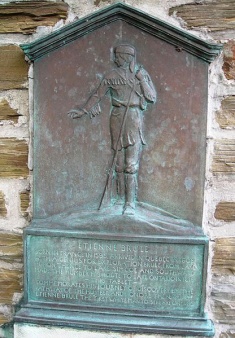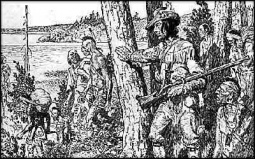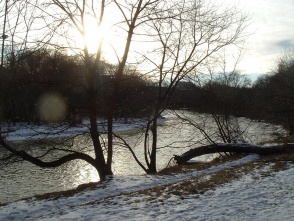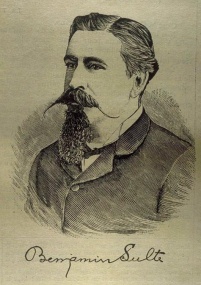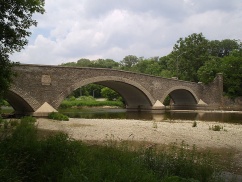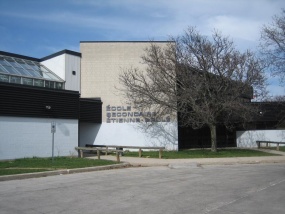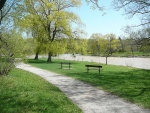Étienne Brûlé, The First Franco-Ontarian
par Saint-Pierre, Stéphanie
Étienne Brulé, despite being an occasional sidekick to Samuel de Champlain, is an obscure character in the history of New France. He left no writings and we know very little about his life. The accounts of life, as few as they may be, have nonetheless have undergone many changes in the last 400 years. Sometimes presented as a traitor and at other times a hero, people are fascinated by his scandals, his achievements, and the mystery surrounding his death. Today, he is celebrated as the first French settler to have lived in the territory that is now the province of Ontario. Some view him as the founder of the French-speaking community in Ontario.
Article disponible en français : Étienne Brûlé, premier Franco-Ontarien
Brûlé's Life
We can be certain about very few facts regarding Étienne Brulé's life. Because he left no writings, these facts are recounted by his contemporaries (Champlain, Récollet Gabriel Sagard and the Jesuits Jean de Brébeuf, François-Joseph Le Mercier and Paul Le Jeune). Étienne Brûlé was born in 1592, in France, probably in Champigny-sur-Marne close to Paris. He arrived in New France in 1608 at the age of 16 and was one of the first inhabitants of Quebec City. In 1610, Champlain sent him to spend the winter with the Algonquins with chief Iroquet. That year, the Algonquins were spending the winter in Huronia (or land of the Hurons). This allowed Brûlé to become familiar with the Huron language and also made him the first European to visit the territory that is now the province of Ontario. This fact is considered to be very important for many historians. Brûlé became an intermediary and an interpreter for Champlain, relaying and translating messages. In 1615, during an expedition ordered by Champlain, Brûlé left the group in order to follow some of the Hurons to what is now the East coast of the United States. At that time, the area was inhabited by a tribe the French called the Andastes(NOTE 1). In 1618, Brûlé saw Champlain again and gave an account of his adventures, which were subsequently published in one of Champlain's works in 1619. Brûlé continued his work as an intermediary, working with various Native groups. During this period, his contemporaries often described him as employing "crude ways". In 1629, he helped the Kirke brothers capture Quebec City, an act sharply criticised by Champlain. When Champlain and the French regained the colony, Brûlé was already gone. He was apparently assassinated in Huronia during the winter of 1632-1633.
The events surrounding Brûlé's death remain very mysterious. The Récollet missionary Gabriel Sagard who spent the winter with Brûlé and the Hurons in 1623-1624 had returned to France at the moment of his death. Nonetheless, he ventures to write that Brulé's body was eaten by the Hurons. Eventually, this version of events came to be used by historians for quite some time. The Jesuit Relations speak of Brûlé's grave and negotiations with the Hurons concerning the creation of a Christian cemetery where he would have been buried. However, negotiations failed and no cemetery was created. It is written in the Relations:
"Truly, there is much to admire about the secret judgements of God, because that vile person did not merit this honour and, honestly, we would have had a great deal of trouble trying to to build a cemetery for him. It would have been difficult to bring such a body onto holy ground, particularly one that led such a scandalous life and gave the Savages such a bad impression of the customs of the French (NOTE 2)".
A Matter of Interpretation
Brûlé played both a marginal and a central role in the history of New France. Some say he played a small role because very little is known about him and, for the most part, historians mention him rather summarily (NOTE 3). However, in the eyes of other historians, his role was central because he represents the beginning of the history of French Ontario. He was the first French person to set foot in the "Pays-d'en-Haut" [Upper Country] (Native land around the Great Lakes). Historians sometimes ignore Brûlé completely, mentioning only 1610 as the date of the founding of French Ontario. This is earlier than the 1615 date that Champlain mentions previously as the date he set out for the Pays-d'en-Haut. What is more, some view Étienne Brûlé not only as the first Franco-Ontarian, but as an outright hero for French Ontario.
Despite knowing very little about him, there are infact six versions of his life story. Some are narratives which have the support of entire groups of historians. Other versions have only one sole supporter. The validity and arguments for various versions are influenced by many factors including the passage of time, changing societal norms and customs, as well as the sources cited and approaches used to analyse the various accounts.
The first version of his life story is established by his contemporaries. This version serves as a point of reference for all subsequent versions. It is the most complete version, but it is laden with harsh religious opinions critical of Brûlé's unorthodox behaviour. In addition ,references to him are often vague or ambiguous. For example, Champlain refers to him as "mon garcon" [my boy] or as "mon truchement" [my intermediary] leaving the onus on the reader to make the link between the anonymous characterand Brûlé.
The second account of his life story is that of some of the French elite and the clergy. This is the version used in the historiography of the French regime, promoted by the Jesuit columnists François-Joseph Du Creux and Pierre-François-Xavier de Charlevoix. This version was used until the 1950s when it even appeared in the biography of Samuel de Champlain written by Narcisse-Eutrope Dionne. It is interesting to note that none of these authors make reference to Sagard. The authors give occasional accounts of Brûlé's travels, however, the man is presented as an immoral traitor who is assassinated because of his troublesome and sometimes foolish behaviour. The citation most often mentioned by this group of historians is taken from Champlain's records. It says that Brûlé is a man who was "vicious with a weakness for women".
The third account of his life co exists with the second and is mostly upheld by English-speaking historians and by a lone French-speaking historian, Benjamin Sulte. Their desire to make Brûlé a hero is obvious and hence certain dubious interpretations appear in their writings. The most flagrant example is the way they present the capturing of Quebec City by the Kirke Brothers. Certain historians present this as a liberating event in which Brûlé plays the role of saviour. According to this account, his actions were not motivated by economic gain nor were they acts of treason. Rather, he had the noble intention of saving the inhabitants of Quebec from certain starvation...
The fourth account of his life story is upheld by two individuals: Marcel Martel and Lucien Campeau. Martel poses certain questions about the details of Brûlé's travels and Campeau writes a very interesting biographical note in his lengthy piece of work called Monumentae Novae Francia. Campeau seems to have consulted original documents previously ignored consulted. However, because it is only a biographical note, Campeau does not cite his sources. According to Campeau, Brûlé is in London when he decides to help the Kirke brothers in capturing Quebec. He is married and makes at least one voyage to France from 1608 until his death in 1632.
The sixth and final account of Brûlé's life comes from Bruce G. Trigger, an anthropologist specializing in the Huron people. He is very sceptical regarding Brûlé's diplomatic role. According to Trigger, Brûlé is much too young to have any influence on the Hurons since the Huron people value wisdom developed over time. Trigger also speaks of Brûlé's death, which is treated as a heinous murder in most versions. Trigger concludes that his death cannot be due to murder motivated by jealousy or by Brûlé's eccentric behaviour. He believes that Brûlé's death is politically motivated. According to Trigger, he was murdered in order to eliminate the threat posed by the so-called "Neutral native nations" that Brûlé had visited. The Huron's role as intermediary with respect to the French was very lucrative in the fur trade. In killing Brûlé, the people in fact wanted to protect their source of income.
Recognition of Heritage and French Cultural Identity in Ontario
Brûlé is presented from different angles by historians. However, beyond formal history, he has developed a following that considers him as a hero from New France. This is especially the case of French-speaking Ontario. It is a fairly recent development, which demonstrates the importance he is given in amateur publications. For example, the Toronto Historical Society produced a comic strip in which he figures as the main character (NOTE 4) and the Féderation de la Jeunesse Franco-Ontarienne FEFSO [Franco-Ontarian Youth Federation] also gives a positive spin on Brulé in a publication called Notre Histoire (NOTE 5), in which he is presented as the first Franco-Ontarian. On the province's web site, he was, until recently, presented as a hero (NOTE6). Upon verification, it was discovered that the section in which he appeared was formerly called the Annuaire des Célébrités Ontariennes [List of Famous Ontarians](NOTE 7).
Brûlé's importance for Ontario is also reflected in the names of various buildings. His name appears in the names of three schools in the province, including one French-language school. The École Secondaire Étienne Brûlé of North York, founded in 1969, was the first French-language secondary school in the Greater Toronto Area. Étienne Brûlé Junior High School of Etobicoke and Étienne Brûlé Public School of Sault-Ste-Marie are English-language schools. There is also a park named after him in Toronto as well as an observation point in Parc de la Gatineau.
Whether he should simply be considered a French historical figure or as the first Franco-Ontarian, his significance has evolved as the social context and customs have changed over the years. What is particularly important for Franco-Ontarians is the 1610 date of Brûlé's first visit to the territory that is now known as the Province of Ontario. Furthermore, the fact that various educational institutions are named after him shows just how much the societal norms of French Canadians have changed over time. In the 19th century, the accepted code of conduct closely followed well-established norms established by the Church of Rome. The fact that he was a Frenchmen who had decided to live like one of the natives was not well received among his own people. Thus, he was described as a "vicious individual with a weakness for women" and as someone who betrayed France to help England. Consequently, it was difficult to consider him worthy of a hero status. However, considering the same facts today, Brûlé is now considered as being adventurous, courageous and audacious if not even "noble".
Stéphanie St-Pierre
Doctoral Student (Université de Montréal) and university Instructor (Université Laurentienne)
NOTES
Note 1: Their traditional territory covered what is now the states of Maryland, Delaware, and Virginia. The Susquehanna River was their main centre of activity.
Note 2: « Relation de ce qui s'est passé en Nouvelle-France en l'an 1636 » dans Thwaites, vol. 10, p. 310.
Note 3: Their are nonetheless some biographies written about Brûlé, such as those written by Consul Wilshire Butterfield, James Herbert Cranstan and Jean-François Beaudet.
Note 4: BOUCHARD-MÜLLER, Josette Bouchard-Müller, Etienne Brûlé 1592-1633: Entre l'Histoire et la légende: Un mythe franco-ontarien, Toronto, La Société d'histoire de Toronto, 1994. 25 p. This comic strip illustrates Brulé's life and "attempts to offer a more realistic image of Brulé's character that is in keeping with some of the more recent historical discoveries."
Note 5: Félix Saint-Denis, "Notre histoire", p. 30 dans « Guides et fascicules », Fesfo, site consulté le 04/02/09 [online], http://fesfo.ca/assets/pdf/fascicules/notre_histoire.pdf
Note 6: Gouvernement de l'Ontario, site consulté le 26/01/04 [online] http://www.kids.premier.gov.on.ca/french/history/famous.asp#heroes.
Government of Ontario, site consulted 26/01/04 [online] http://www.kids.premier.gov.on.ca/french/history/famous.asp#heroes.
Note 7: « Annuaire des célébrités Ontariennes », Gouvernement de l'Ontario, site consulted on 04/02/09 [online] http://www.onzone.ca/french/ontario/famous/famous.asp
BIBLIOGRAPHY
BEAUDET, Jean-François Beaudet, Étienne Brûlé, coll. Célébrités canadiennes, Montréal, Lidec, 1993, 61 p.
BUTTERFIELD, Consul Wilshire, History of Brulé's discoveries and explorations, 1610-1626, Réimpr., Cleveland, Helman-Taylor, 1898, Grand Rapids, Michigan, Black Letter Press, 1974, 184 p.
CHAMPLAIN, Samuel de, Les œuvres de Champlain, Tome I, Abbé Charles-Honoré Laverdière (éd.) Réédition présentée par Georges-Émile Giguère, Montréal, Éditions du jour, 1973 (1870), 849 p.
CHAMPLAIN, Samuel de, Les œuvres de Champlain, Tome II, Abbé Charles-Honoré Laverdière (éd.) Réédition présentée par Georges-Émile Giguère, Montréal, Éditions du jour, 1973 (1870), 849 p.
CRANSTON, J. Herbert, Etienne Brûlé: Immortal Scoundrel, Toronto, Ryerson Press, 1949, 144 p.
DOUGLAS, Gail, Étienne Brûlé : The Mysterious Life and Times of an Early Canadian Legend, Canmore, Amazing Stories, coll., Altitude Publishing Canada Limited, 2003, 133 p.
Relations des jésuites (Les), Édition par Reuben Gold Thwaites, The Jesuite relations and allied documents: travels and explorations of the Jesuit missionaries in New France, 1610-1791: the original French, Latin, and Italian texts, with English translations and notes, Cleveland, Burrows, 1897, 36 tomes, ill., cartographié.
SAGARD, Gabriel, Le grand voyage du pays des Hurons : situé en l'Amérique vers la mer douce, és derniers confins de la Nouvelle France, dite Canada, ou il est amplement traité de tout ce qui est du pays, des moeurs & du naturel des Sauvages, de leur gouvernement & façons de faire ... avec un dictionaire de la langue huronne, pour la commodité de ceux qui ont à voyager dans le pays,& n'ont l'intelligence d'icelle langue, Paris, Chez Denys Moreau, 1632, 528 p.
ST-PIERRE, Stéphanie, « Étienne Brûlé: la création d'un personnage », Revue du Nouvel-Ontario, no 29, 2004, p. 5-44.
Additional DocumentsSome documents require an additional plugin to be consulted
Image
Document PDF
Hyperliens
- [in French] L'écho d'un peuple : sur la piste d'Étienne Brûlé
- [in French] Centre de recherche en civilisation canadienne-française : texte sur le destin tragique d'Étienne Brûlé

